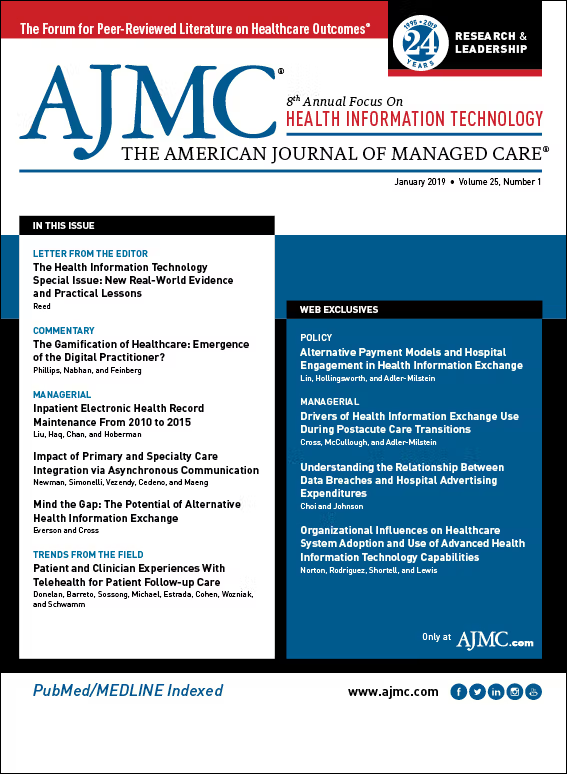Publication
Article
The American Journal of Managed Care
The Gamification of Healthcare: Emergence of the Digital Practitioner?
Author(s):
Gamification in healthcare is gaining momentum, with attempts to apply gaming principles to improve patient clinical outcomes. This trend establishes the need for a “digital practitioner” who channels these games, monitors progress, and selects the most appropriate ones for a given patient.
ABSTRACT
The application of behavioral economics principles in healthcare has been transformed through the use of technology and recently the advent of video gaming concepts, or gamification, to modify patient behaviors. The role of practitioners in the era of gamification has not been well established, but it is possible that the need has arisen for development of clinical practice guidelines and the “digital practitioner”: one who specializes in healthcare apps, accepts referrals from other practitioners, identifies the best programs to meet individual patient needs, and consults to assess whether game apps might improve clinical outcomes.
Am J Manag Care. 2019;25(1):13-15Takeaway Points
- Understanding how gamification applies to healthcare is essential. Gaming principles can be selectively applied to how care is coordinated and delivered to patients, potentially leading to better outcomes.
- Rigorous regulatory processes are essential for safe applications of such principles to patient care. Current FDA guidelines continue to be refined.
- Clinical guidelines regarding when gamification is appropriate for patients are also needed. This trend establishes the need for a “digital practitioner” or a “digital consultant” who helps navigate the gamification process, selects proper healthcare applications, and decides on monitoring and appropriate outcomes to be derived from these applications.
- The ubiquitous use of software and smartphones establishes that we are in the era of gamification in healthcare and that understanding how to practically incorporate such applications in patient care is urgently needed.
Principles of behavioral economics transcend many industries, including healthcare.1 One such principle recognizes that although a rational actor will make decisions based on the most beneficial outcomes or utility, humans commonly demonstrate irrationality by acting against their own self-interest, even when they are aware of the implications of their actions. Such irrational behavior may have broad consequences for disease prevention and treatment. Sedentary lifestyle, obesity, smoking, recreational drug abuse, excessive alcohol consumption, and nonadherence to prescribed medical treatments represent examples of irrational health behaviors.
Behavioral economists have developed interventions to overcome unhealthy behaviors based on their understanding of the heuristics and biases underpinning these irrational behaviors.1 One interventional method is “nudging,” which refers to any aspect of the choice architecture that alters people’s behavior in a predictable way without forbidding any options or significantly changing their economic incentives.2 In healthcare, techniques such as targeted diet programs and support groups for smoking cessation, among others, have been introduced to drive behavior modifications with varying success. Regardless of the form an intervention takes, patients must adopt the recommended behavioral change to achieve success.
Concurrent with advancements in behavioral economics was the cultural explosion of video gaming as entertainment that engages participants emotionally and mentally. The premise is rather simple: People enjoy playing games and winning. Popular culture, social media, and the ubiquity of smartphones have fed into the desire to play and win. For instance, the Candy Crush Saga video games, developed by the interactive media company King, have been downloaded more than 2.73 billion times since their debut in 2012 and contribute to more than 70,000 miles being “swiped” on interactive screens daily.3 The development of interventional strategies that combine the unparalleled success of such gaming concepts with the positive reinforcement and motivation of the nudge to overcome human irrationality and address unhealthy behaviors and undesirable clinical outcomes is a welcome approach. Enter the gamification of healthcare, defined generally as the use of game design elements in the context of positive health motivation.4
The compelling science of behavioral economics, the proven effectiveness of the nudge, and the provocative case of gamification to engage patients have resulted in a relative explosion of healthcare game products. In some software applications, patients compete with themselves by challenging personal goals to achieve high score validation, whereas in other applications, patients compete against other individuals.5 Gamification can be used to motivate patient-controlled behaviors and has already been studied in a wide variety of disease states. A systematic literature review by Sardi et al found that gamification began to attract researchers in the e-health realm in the second half of 2010.6 Sardi et al identified 46 studies as presenting gamified applications with mixed effectiveness results.
The simplistic fundamental principle taught to all healthcare professionals, “first, do no harm,” is challenged by the complexities of modern medicine. To assume that therapies will always be both safe and effective ignores daily realities. A more contemporary definition might read: “When accompanied with adequate warnings and used as intended under the supervision of a physician, the benefits of approved prescription drugs and devices should outweigh the risks.” We raise this point to introduce fundamental questions related to the rapid growth of gamified health apps: Do they need to be regulated? Can they cause harm? Should they be prescribed and used under medical supervision?
Regulatory Framework
The FDA has recognized the proliferation of software programs in healthcare and, to date, has regulated these products as medical devices when their intended use is to treat, diagnose, cure, mitigate, or prevent disease, referring to them as “software as a medical device.” The 21st Century Cures Act has provided greater clarity on which software is required to be regulated as a medical device by exempting from regulation those programs that are used “for maintaining or encouraging a healthy lifestyle and are unrelated to the diagnosis, cure, mitigation, prevention, or treatment of a disease or condition.”7 Although many games in healthcare may fall into this exempt category, the ones that adapt to the user experience and have a role in the previously mentioned disease processes would require regulatory review and approval. In some instances, such a designation would restrict games with a potentially harmful effect to use under the supervision of a physician under current regulations (21 CFR 801.109). In recognizing current regulatory limitations, the FDA has proposed a Digital Health Innovation Action Plan, which would create a “risk-based approach to regulating digital health technology,” focusing resources on those digital products that may pose the greatest risk to patient safety.8
Clinical Assessment
In applying a medical device approach to gamified apps, patient safety concerns resulting from mechanical malfunction and design flaws must be considered. From a mechanical perspective, software technology developers and the smartphone manufacturers who enable their deployment are readily able to construct designs that lack defects. However, the problematic abuse of smartphone apps has been well described, including instances in which patients can experience symptoms that mirror addiction, such as excessive use and separation anxiety.9 The DSM-5 has even proposed diagnostic criteria for “internet gaming disorder.”9 Is it too far-fetched to imagine a gamified weight-loss app that gives rise to eating disorders? Although gamification in healthcare has the potential to modify behaviors, participating in gaming is innately a behavior that may result in unintended consequences. Given concerns both real and imagined, it does not seem unreasonable for gamified health apps to undergo an assessment of efficacy and safety before being released to the public.
Practitioner Interventions
The role of practitioners in the era of gamification has not been well established, but clinical practice guidelines for game selection may be on the horizon. Noncompliance with and nonadherence to prescribed medical treatments are problems that seem well suited to alternative motivational strategies. Conceptually, a variety of disease states could be avoided or their progression substantially halted by more rational patient behavior, which might similarly be positively influenced through game application. Clinical examples include diet and exercise in patients with cardiac disease, smoking cessation in patients with chronic obstructive pulmonary disease, and lifestyle modification in patients with type 2 diabetes. Given that these chronic diseases have significant management costs, it would seem appropriate that physicians monitor the gamified apps in such clinical scenarios. The clinical spectrum of gamification in medicine may not be limited to motivating patients; rather, healthcare providers themselves may benefit from their use as process improvement and interventional research tools.
The Path Forward
As gamification and software platforms become more accepted, it is possible that the need arises for the new world of the “digital practitioner”: one who specializes in healthcare apps, accepts referrals from other practitioners, identifies the best programs to meet individual patient needs, and consults to assess whether game applications might improve clinical outcomes. Getting to this point will require new assessment tools validated via real-world evidence and comparative effectiveness research. Just as patients vary in their responses to medications, it is reasonable to assume that some patients will benefit more from one game over another. A 2-way gaming interface could permit the digital practitioner to monitor the progress of the patient, address any deficiencies that might be noted, and adjust the game accordingly. Noted deficiencies could include lack of adherence to the program, skipping levels, and successes or failures in maintaining targets.
Technological advancement in healthcare is in an explosive growth phase, and there is likely a role for gamification as a next approach to modify behavior. As gamified applications for healthcare increase, the best way to protect patients is with a combination of provider and regulatory interventions.Author Affiliations: Cardinal Health Specialty Solutions, Cardinal Health (EGP, CN, BAF), Dublin, OH.
Source of Funding: None.
Author Disclosures: The authors report no relationship or financial interest with any entity that would pose a conflict of interest with the subject matter of this article.
Authorship Information: Concept and design (EGP, CN, BAF); acquisition of data (EGP, CN, BAF); analysis and interpretation of data (EGP, CN, BAF); drafting of the manuscript (EGP, CN, BAF); critical revision of the manuscript for important intellectual content (EGP, CN, BAF); and administrative, technical, or logistic support (EGP, CN, BAF).
Address Correspondence to: Eli G. Phillips Jr, PharmD, JD, Cardinal Health Specialty Solutions, 7000 Cardinal Pl, Dublin, OH 43017. Email: eli.phillipsjr@cardinalhealth.com.REFERENCES
1. Volpp KG, Asch DA, Galvin R, Loewenstein G. Redesigning employee health incentives—lessons from behavioral economics. N Engl J Med. 2011;365(5):388-390. doi: 10.1056/NEJMp1105966.
2. Thaler RH. Nudge, not sludge. Science. 2018;361(6401):431. doi: 10.1126/science.aau9241.
3. Takahashi D. Candy Crush Saga: 2.73 billion downloads in five years and still counting. VentureBeat website. venturebeat.com/2017/11/17/candy-crush-saga-2-73-billion-downloads-in-five-years-and-still-counting. Published November 17, 2017. Accessed October 2, 2018.
4. Kawachi I. It’s all in the game—the uses of gamification to motivate behavior change. JAMA Intern Med. 2017;177(11):1593-1594. doi: 10.1001/jamainternmed.2017.4798.
5. Von Bargen T, Zientz C, Haux R. Gamification for mHealth: a review of playful mobile healthcare. Stud Health Technol Inform. 2014;202:225-228. doi: 10.3233/978-1-61499-423-7-225.
6. Sardi L, Idri A, Fernández-Alemán JL. A systematic review of gamification in e-health. J Biomed Inform. 2017;71:31-48. doi: 10.1016/j.jbi.2017.05.011.
7. Changes to existing medical software policies resulting from section 3060 of the 21st Century Cures Act: draft guidance for industry and Food and Drug Administration staff. FDA website. www.fda.gov/downloads/MedicalDevices/DeviceRegulationandGuidance/GuidanceDocuments/UCM587820.pdf. Published December 8, 2017. Accessed August 23, 2018.
8. Digital health innovation action plan. FDA website. www.fda.gov/downloads/MedicalDevices/DigitalHealth/UCM568735.pdf. Published 2017. Accessed October 4, 2018.
9. Panova T, Carbonell X. Is smartphone addiction really an addiction? J Behav Addict. 2018;7(2):252-259. doi: 10.1556/2006.7.2018.49.




